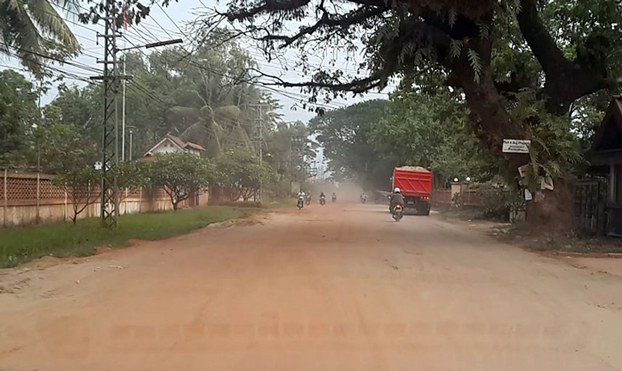




High-ranking officials in Laos have been tapping state coffers to build roads to their private residences, prompting outrage among citizens who say such funds are needed to repair main thoroughfares used by the public, sources inside the country said.
In April, the Ministry of Public Works and Transport approved 400 million kip (U.S. $50,000) to build a 600-meter-long, five-meter-wide road to the home of Bounthong Chitmany, a Politburo member, chairman of the Lao Anti-Corruption Organization and president of the Government Inspection Authority.
The road will be built in Phakhao village along a major route in the Saysettha district of the capital Vientiane.
“Why are the bosses in each office all the same?” said one Vientiane resident who declined to be named. “They use the budget to build roads to their own homes mostly without thinking that there still are people in many other places or villages that want roads. [I] want them not to be selfish, but to see what is important or needed.”
The ministry assigned its Public Works Department and Vientiane’s Public Works and Transportation Department to oversee construction of the road, according to a notice issued on April 29 by the ministry, which was obtained by RFA’s Lao Service.
Detsongkham Thammavong, chief of Vientiane’s Public Works and Transportation Department declined to answer questions posed by RFA about the building of the road.
In addition, Pheng Douang-ngeun, director general of the Road-Bridge Department at the Ministry of Public Works and Transport had requested state funds to build a road to his house in Nonway village, Saysettha district, in Vientiane, according to a ministry source and a May 13 request from Vientiane’s Public Works and Transport Service. However, the cost of the project was not specified.
“This is selfish and inappropriate behavior by the officials because they do not pay attention to improving and developing the roads to meet the demands of the people, and public roads are left dirty and badly damaged,” another Vientiane resident told RFA.
In fiscal year 2014-2015, the Ministry of Public Works and Transport approved 800 million kip (U.S. $100,000) to repair 12 roads throughout Vientiane, which fell short of the amount needed for all roadway repairs in the capital, according people with knowledge of the matter, who declined to be named. The Vientiane Public Works and Transportation Department required an additional 6 billion kip (U.S. $742,300) according to information from the ministry.
Loans tied to corruption
Heavily used main roads in and around Vientiane such as ones running from Jinaimo junction to the Ban Home villages, and from the Donoun junction and Thangone village in Xaythany district have caused problems for motorists for the last two years, sources said. They have been damaged by heavy trucks and nonstandard construction that create dusty conditions.
The construction and repair of main roads throughout the country have been financed through loans with high interest rates and are said to be tied to corruption because their borrowing costs are higher than usual in the country, according to a source in the Ministry of Public Works and Transport.
Last month, a road construction expert speaking on condition of anonymity told RFA that an upgrade scheme in Vientiane led by the son of Lao Prime Minister Thongsing Thammavong was expected to cost four times more than similar projects.
The road linking Laos National University’s Dongdok campus to Route 13 North would cost an estimated U.S. $80 million to upgrade, according to a survey conducted by Chinese firm The Third Railway Survey and Design Institute Group Corporation (TSDI) between November 2014 and January 2015.
The Chinese company, which reportedly has connections to members of the Lao national leadership, estimated that work on the nine-kilometer (5.5-mile) long, 28-meter (92-foot) wide road, which was built a decade ago, would cost slightly less than U.S. $9 million per kilometer (0.6 mile).
But the road construction expert said it should cost no more than U.S. $2.2 million per kilometer, including administrative expenses.
Corruption among high-level officials in Laos has been going on for years, if not decades. Graft in the one-party state is so widespread that it has deterred foreign investors, created problems with the country’s ability to enforce business contracts and regulation, and left many ordinary citizens frustrated and impoverished.
In 2014, Lao ranked 145 out of 175 countries on corruption in the nongovernmental organization Transparency International’s corruption perception index, which scores nations on how corrupt their public sectors are seen to be.
Reported by RFA’s Lao Service. Translated by Ounkeo Souksavanh. Written in English by Roseanne Gerin.